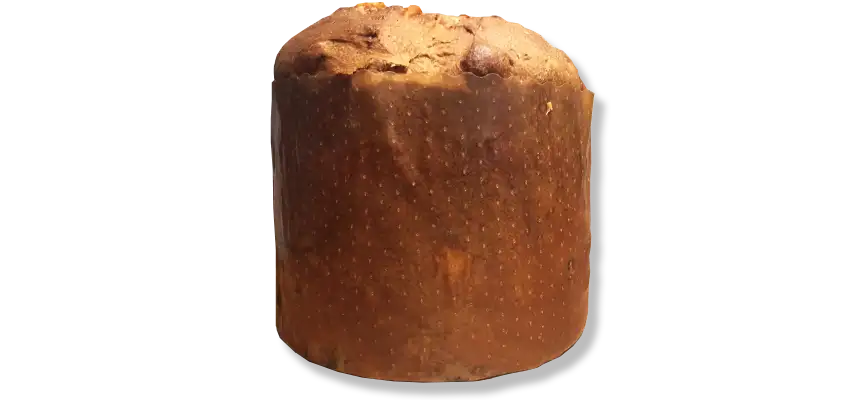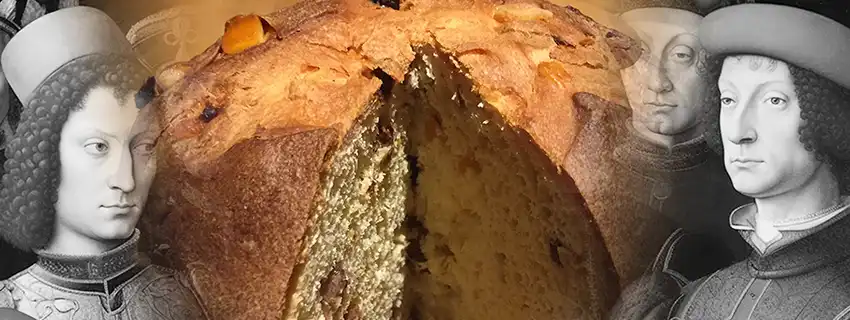Published:
Author: Antonio Maria Guerra
Panettone
THE COMPLETE GUIDE TO THE MILANESE CHRISTMAS BREAD

Panettone bread is one of the most typical Christmas desserts in Italy, whose origins are closely linked to the city of Milan. Let’s deepen our knowledge of a delicacy that is increasingly appreciated all over the world, starting with what it is, then discovering the original recipe and its ingredients, the calories, the many variations, the best combinations, and much much more, including the most traditional Milanese pastry shops where you can enjoy the original specialty.

What is Panettone?
In September 2003, the characteristics and production methods of Panettone bread were officially laid down in a specification drawn up by a committee of Milanese pastry chefs. The contents of this document were then implemented by a Decree of the Italian Ministry of Productive Activities (*1).

The ‘official’ definition of Panettone is as follows:
A soft bakery confectionery product made by natural fermentation from sourdough, with a round base and a characteristically cracked upper crust, it has a smooth structure with elongated alveolation and the typical aroma of sourdough leavening.
Notes:
*1: Decree July 22, 2005, published in the Official Gazette No.177, 01/08/2005.
Let’s find out the history of panettone bread and many curiosities in the article we dedicated to the exquisite Christmas specialty.

Milan: the city of panettone.
Milan, the bithplace of panettone, has very ancient origins, which according to some experts date back to the classical period, if not even earlier.
Read more
Today it is a cosmopolitan metropolis, a reference point for the Italian economy and culture. A special place that can blend tradition and modernity, offering its citizens and visitors the Gothic style of the famous Duomo and the futuristic profile of newly designed skyscrapers.

How do you recognize the authentic Milanese panettone?
Genuine Milanese panettone has a minimalist appearance, worthy of a design exhibition, as it combines the classic and the modern. It is characterized by its tall, cylindrical shape, crowned by a soft dome. An inviting aroma of vanilla, candied citrus, sugar, and natural yeast marks the beginning of an experience that continues with the cutting of the dough, which is soft and deep yellow, evenly alveolar and pleasantly elastic. On the palate, the flavor is rich and lingering, with eggs, butter, vanilla, and sultanas dominating.

Panettone by Motta.
This article was made in collaboration with Motta. The company, of primary importance in the Italian confectionery scene, is closely linked to the Milanese panettone. In fact, it boasts a tradition in its production of more than a century.
Read more
It’s not surprising, therefore, that since its origins as ‘pasticceria artigianale’ (‘artisan pastry shop’, founded by Angelo Motta), it has played a key role in promoting this specialty to a broad audience, actively working to make it known and appreciated at a national level.

Recipe of panettone. (hints)
It’s important to point out that making panettone is not an easy task and that, if you decide to do it by hand (*1), you’ll need additional skills and, above all, a lot of effort. It’s therefore not surprising that an artisan dessert of this kind is much more expensive than one made industrially using special machinery. However, it’s important to admit that the difference in taste is often obvious from the first bite. So, let’s find out what it takes to make this sweet delicacy:
1) Dough preparation;
2) First rising;
3) ‘Spezzatura’ (‘breaking’): the dough is divided into equal parts;
4) ‘Pirlatura’: the dough portions are rounded.
5) Placing of the dough in the ‘pirottino’ (*2);
6) Final rising of the dough inside the ‘pirottino’;
7) ‘Scarpatura’: an operation consisting of making a cross-shaped cut in the upper part of the risen dough, the so-called ‘dome’;
8) Baking;
9) Cooling: the panettone is turned inside out (so that the top retains its dome shape without squashing) and allowed to cool.
Notes:
*1: It’s still possible to use tools such as, for example, the mixer;
*2: ‘Pirottino’: paper mold used to give this dessert its typical cylindrical shape;
The preparation of panettone bread in video.
This video shows how to make panettone. Thanks are due to the friendly Ian Spampatti, its author and owner.

The oldest pastry shops in Milan.
The following is a brief list of the oldest Milanese pastry shops where it’s possible to buy classic Panettone.
Read more
- Pasticceria Cova
Via Monte Napoleone, 8, 20121 – Milan – ITALY
Official Website - Pasticceria Sant Ambroeus
Corso Giacomo Matteotti, 7, 20121 – Milan – ITALY
Official Website - Pasticceria Viscontea
Via Edmondo de Amicis, 39, 20123 – Milan – ITALY
Official Website - Pasticceria Marchesi
Galleria Vittorio Emanuele II, 20121 – Milan – ITALY
Official Website

The ingredients of panettone bread.
Di seguito un elenco dei principali ingredienti utilizzati nella preparazione del panettone classico:
- Wheat flour (type 0);
- Sugar;
- Hen eggs;
- Butter;
- Raisins;
- Candied citrus peels (citron and orange);
- Natural yeast;
- Salt;
It should be noted that the specifications allow other ingredients such as milk, honey, malt, and cocoa butter, as well as various emulsifiers and preservatives. The producers are also allowed discretion in the quantities to be used (but not less than certain percentages) and in the preparation method (e.g. the number of doughs and leavening agents). This discretion can be considered their ‘secret recipe’ for the perfect Milanese panettone bread.

The panettone mold.
Almost unexpectedly, the mold is an element of fundamental importance in the preparation of the original Milanese Panettone bread. It has a rather unique name, undoubtedly quite fun: ‘pirottino’. Strictly cylindrical in shape, it’s made of food-grade paper, resistant to high temperatures, and has the dual function of supporting the dough while it rises and then containing it during baking.

The shapes of panettone bread.
As explained in the previous paragraphs, the ancestor of panettone was nothing more than a ‘big bread’ particularly rich in ingredients, low and rounded (img. 1). In the first half of the twentieth century, the businessmen Angelo Motta and Gioacchino Alemagna introduced the use of the ‘pirottino’: thanks to this special paper molt, the panettoni they produced took on the typical tall, cylindrical shape, characterized by a domed top (img. 2). Recently, some bakeries and pastry shops in Milan have returned to offering their customers a lower panettone, clearly referring to the original tradition (img. 3).

The right wine for Panettone bread.
Which wine to drink with a delicious slice of panettone bread? The possible choices are many, but the best is probably a white wine, sweet, fresh, and sparkling. For example, a good Moscato d’Asti.
- Its delicate sweetness can accompany that of the panettone without overpowering it.
- Its acidity, delicate sapidity,and slight effervescence can balance the fattiness of the dough.

The varieties of modern Panettone bread.
As is often the case with the ‘classics of taste’, today’s panettone bread has many variations to satisfy the constant desire for the novelty of an increasingly demanding public. This has led to the creation of delicious specialties such as chocolate panettone (undoubtedly one of the most popular) and pistachio panettone. There is no shortage of types for those with special dietary needs (such as gluten-free). And what to say about the savory panettone (or ‘gastronomic panettone’), enriched with layers of fillings made with ingredients ranging from meat to fish, from vegetables to sausages, and so on. It seems that the only limit is the imagination of the cook.

Panettone bread: calories and nutritional values.
Although Panettone bread cannot be considered a diet food, it is well known that, in the name of taste, sometimes it’s possible to make exceptions, especially during the Christmas holidays. That said, 100 grams (a slice, give or take) of this sweet delicacy contain, on average, between 350 and 450 calories.
Read more
Its nutritional content is characterized by carbohydrates (with an abundance of sugar), fat (mainly saturated) and a fair amount of protein, vitamins (especially B and D vitamins) and minerals (especially iron), due to the use of ingredients such as fresh eggs, butter, raisins and candied fruit.

How long does panettone bread last?
The shelf life of panettone depends on the way it has been produced: in the case of industrial panettone, if the packaging remains intact, thanks to the preservatives used, it can easily reach 6 or even 9 months. Once opened, it’s best to consume the specialty within 6/7 days. It must be stored in the original bag, closed carefully, and kept in a cool, dry place (not the refrigerator).
Artisan panettone (panettone ‘artigianale’), which does not contain stabilizing additives, has a much shorter shelf life: about one month, if the package is closed. Once opened, it should be consumed within a maximum of 3/4 days.

Can panettone be frozen?
Although it’s not a very advisable practice, it’s possible to freeze panettone bread, whether industrial or artisanal. The best way to do this is to wrap the specialty (preferably in slices) using food wrap and then place it in a freezer bag. While the classic panettone (with raisins and candied fruit) can be kept for up to 90 days (approximately), great care must be taken with filled products, since creams are generally subject to rapid deterioration. Once removed from the refrigerator, panettone should be allowed to thaw at room temperature.

Motta: contacts.
This article was made in collaboration with Bauli S.p.a., the company that owns the brand of Motta, the historical producer of the colomba cake.
Contacts
Address: Bauli S.p.A – Via Verdi 31 – 37060 Castel d’Azzano (VR) – Italia
Web:https://www.bauli.it/
Tel. : 800 888 166

Copyright information.
The images displayed in this page belong to WebFoodCulture, with the exception of:
Creative Commons Images
- “La Scala, Milan” by Michael Gwyther-Jones is licensed under CC BY 2.0.

